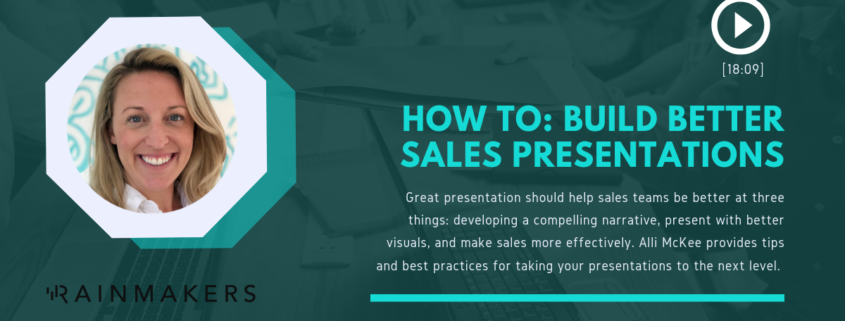[Sales Class] How to Build Better Sales Presentations with Alli McKee
Alli wants to help sales teams be better at three things: Develop a compelling narrative, present with better visuals, and use presentations to make sales more effectively.
Often times every rep on a sales team has a slightly different “franken-deck” that they present from, and most of the good marketing content goes unused. Instead, every rep should tell the same story using the same assets all while can customizing it in their own way to walk the prospect through their specific needs.
How to build your presentation:
There are several elements to building an effective presentation. First, Alli explains, is that you need to start your presentation off by showing how your product improves things compared to the “old way,” whatever that may be for your business. Next, discuss the value of your product and what they will gain by using it, followed by some type of proof like a reputable case study or testimonial. Throughout the presentation, there should be a compelling storyline to keep the audience engaged and interested.
Start your story with “Change” – Show the old way of doing things and the problems associated with it compared to the new, better way of doing things (and how your product plays into that). Focus on the pain of point A to show why getting to point B is valuable.
Talk about what is gained from your product – Discuss the gains from the perspective of the customer, not from your perspective or your product’s perspective. You want them to leave with a clear understanding of the outcome they can achieve with your product and the value associated with your service.
Show proof – It’s not just about volume (showing a ton of logos on a slide). Instead, say “everyone like you is using this” and provide relevant examples.
Add a storyline – Narrative matters, and pitches that include a compelling story have a higher success rate of bringing the discussion to the next stage.
How to deliver your presentation:
How you deliver your presentation is one of the most important pieces to the equation. This is where you get the attention of your audience and have the opportunity to take them on a carefully constructed journey using a clean slide layout, simple graphics, and a discussion that comes off as free-flowing.
Slide layout – When you have text-first slides, your audience is reading, not listening to you. When you have visual-first slides, your audience will look at the slide while listening to you talk about it.
Dont present directly from the proposal – Use slides with less text to help guide the conversation, as opposed to slides with a lot of descriptive text which can be sent to those who weren’t there for the meeting.
Simplify your visuals – Use easy to follow, simple graphics. Graphic overload can confuse the audience and lead to them being disengaged.
Keep it brief – Try to keep your presentation to under 9 minutes. If you go over 9 minutes, try to use that 9 minute point to switch to a demo or an interactive part of the conversation.
Following Up
By going through these steps you can show your audience that you’re conscious of their specific needs and not just going through the motions of a cookie-cutter presentation.
Follow up with a message laying out the audience’s situation today. Address their roles, teams, processes, tools, timing, and goals. Next, take the three biggest concepts/pain points that were discussed and show how specific benefits from your product will solve each of the three problems. This follow-up template can then be turned into their buying guide.
By taking Alli’s advice on building better presentations you can take your sales pitches to the next level, make an instant connection with those you present to, and land more deals.




